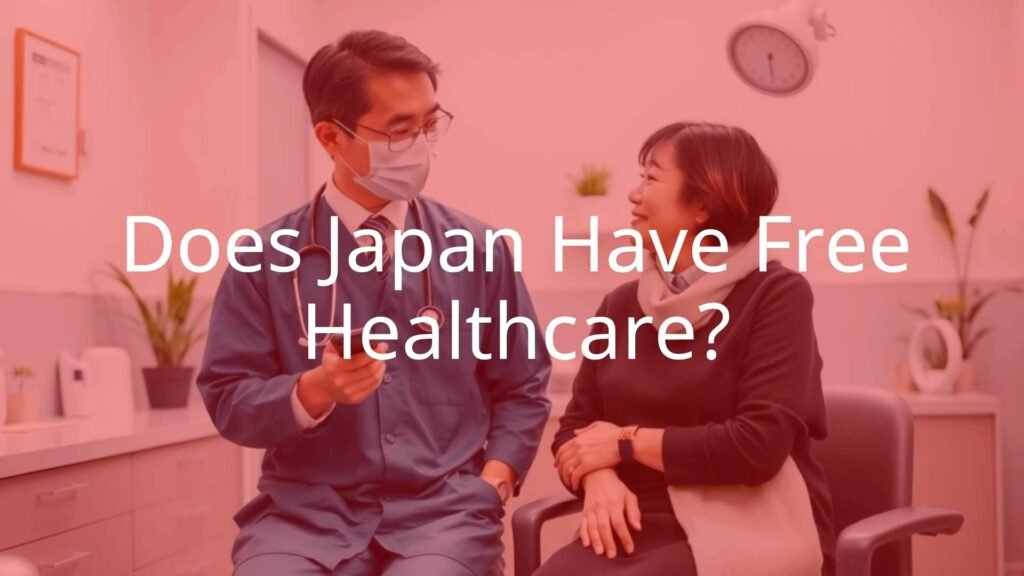Japan is often praised for having one of the best healthcare systems in the world, which is connected to its long average lifespan. However, the idea that healthcare in Japan is totally “free” is a bit misleading. Japan runs a universal healthcare system, meaning all citizens and most foreigners living in Japan long-term are covered. Still, people are expected to pay part of their medical costs themselves-typically through co-payments, insurance premiums, and some direct payments-while the government pays for most of the bill.
This setup lets Japan offer high-quality, easy-to-access healthcare to almost everyone. The system encourages people to focus on staying healthy and helps prevent people from facing huge medical bills. So, while healthcare in Japan isn’t fully “free,” it’s heavily supported by the government to make sure costs are kept reasonable for those who need care.

What Does ‘Free Healthcare’ Mean in Japan?
Calling Japan’s system “free healthcare” isn’t completely correct. What it really means is that everyone has access to medical care no matter their income or job status. Unlike some other countries, in Japan, it’s rare for someone to not get treatment because they can’t afford it or don’t have insurance. The Japanese constitution promises a right to health, and universal healthcare started back in 1961 to make that a reality.
This doesn’t mean people pay nothing. Instead, the costs are split between the government, the employer (if someone is employed), and the individual. The main goal is to keep health services widely available and affordable for everyone, not to make them entirely free at the doctor’s office or hospital.
Is Healthcare Fully Free or Subsidized?
Simply put, Japan’s healthcare is not completely free, but the government pays a large percentage. The main system, called Social Health Insurance (SHI), usually pays around 70% of most medical costs after people have already paid their insurance premium. Patients are responsible for the other 30%. This split can change a little depending on a person’s age or income; younger children and lower-income older people often pay less.

Along with co-payments, everyone pays for health insurance-either taken out of their salary if they work for a company or based on their income if they’re self-employed or not working. This mixed approach is what keeps Japan’s system working for so many people. While it’s not a system where healthcare is totally free, the big government subsidy helps make sure people don’t face extreme financial hardship because of illness or injury.
Universal Health Coverage in Japan
Japan’s healthcare system is considered a social safety net and is something the country is proud of. Anyone who lives in Japan for three months or more, including foreigners, must join a health insurance plan. There are two main types of plans: one for those who work for medium or large companies (employment-based), and another for those who are self-employed, unemployed, or working in smaller companies (residence-based, known as National Health Insurance or NHI).
No matter which plan someone is on, the benefits are almost the same. These include coverage for visits to hospitals, general and specialized doctors, mental health care, prescription medicine, care at home, and most dental services. The government closely controls the prices for health services and provides extra money to keep the system running well. This helps everyone get good care, regardless of where they live or work in Japan.

How the Japanese Healthcare System Works
The healthcare system in Japan is run at both the national and local levels. The country is divided into 47 prefectures, each of which manages healthcare budgets and decisions. This lets local governments adjust programs to better fit local needs, but the main rules, including service pricing, are set by the national government. This gives a mix of national control and local flexibility, helping the system work smoothly in different areas.
In Japan, for-profit businesses usually can’t own hospitals or clinics, except for a few company-based ones. Most hospitals are private non-profit organizations (about 85%), while clinics must be owned by doctors. This focus on care instead of profit helps keep the quality of care high.
Structure of National Health Insurance (NHI) and Employees’ Health Insurance
Japan’s healthcare system is divided into two main categories: Social Health Insurance (SHI) for people who work full-time for medium or large companies, and National Health Insurance (NHI) for the self-employed, unemployed, or those working at smaller companies.
- SHI (Social Health Insurance): Both the employee and employer pay about 5% of the salary each towards insurance premiums. The employer takes care of most of the sign-up and paperwork.
- NHI (National Health Insurance): People not covered by SHI, like freelancers or the unemployed, join this plan. The amount paid depends on income, and sign-up usually involves visiting a local government office.
Both groups pay into a larger fund, which helps keep the finances balanced so everyone can get medical help when they need it.
Who Can Use Public Health Insurance?
Almost everyone in Japan can join public health insurance. This covers both citizens and foreigners staying in Japan for more than three months, including expatriates and digital nomads. Being a part of the system is required for long-term residents.
Foreigners who are new to Japan may need to wait for the enrollment process to finish, which can take some time. During this wait, some people buy private international health insurance so they’re covered right away. Once enrolled and holding the Japanese Health Insurance Card, residents can access care easily. As of now, about 98.3% of people in Japan have public health insurance. The small percentage who don’t are supported by a special program for those without money. No one is left out.
What Costs Do Patients Pay in Japan?
Although the government pays most medical bills, patients still pay some costs themselves. Most of this comes in three ways: co-payments (a set percentage at the time of treatment), regular premiums, and other minor expenses. The goal is to make people partly responsible for healthcare costs, but also to make sure medical bills don’t become a big problem for anyone.
Japan is very open about how much things cost. The government sets prices for medical services with help from doctors. These prices are checked every two years and updated if needed, which helps prevent prices from getting too high.
Copayments, Premiums, and Out-of-Pocket Expenses
- Copayment: Most patients pay 30% of medical fees. The government pays the rest (70%). For example, a visit to a clinic may cost about $33-66 USD (5,000-10,000 yen) with insurance, while a hospital visit is about $66-100 USD (10,000-15,000 yen).
- Premiums: These monthly payments depend on income and family size. Employees’ payments are taken straight from paychecks and matched by employers. Self-employed and unemployed people pay based on their income to the NHI.
- Out-of-Pocket Maximums: If someone spends a lot on healthcare in one month or year, there is a limit to how much they have to pay. If costs go beyond this, the government reimburses the extra. The limits range from about ¥340,000 to ¥2.12 million (about $3,400-$21,200 USD), depending on age and income.

What Is Covered by Insurance?
Japan’s Social Health Insurance System covers most basic and many advanced medical needs. This includes:
- Visits to hospitals and clinics
- General and specialized care
- Mental health care (psychiatric services)
- Most prescription drugs
- Home and hospice care (organised by medical institutions)
- Physical therapy
- Most dental care
- Some preventive care, such as screenings and education
- Certain medical devices, if prescribed by a doctor
This means that for most illnesses or injuries, insurance will pay a big part of the cost.
Extra Costs for Things Not Covered
There are some services and items that aren’t paid for by insurance, so patients must cover them on their own. For example:
- Glasses or contact lenses (only covered for children with certain conditions)
- Optometry services by non-doctors
- Maternity care (though a one-time payment and local support are available)
- Experimental or unapproved drugs and treatments
- Elective or cosmetic surgery
Many residents, especially foreigners, buy private health insurance to cover these gaps, lower their share of co-payments, or get services in English.
Pros and Cons of the Japanese Healthcare System
Advantages
- Universal coverage: Healthcare is available to everyone, not just those who can afford it.
- Long life expectancy: Men live to about 81 and women to around 87 on average.
- High quality of care: Medical care is effective and up-to-date.
- Affordable: Government pays 70% of most costs and there are limits to what people pay out of pocket.
- Focus on prevention: Frequent check-ups and vaccinations help spot problems early.
- Prices are controlled: A government committee sets medical fees, helping keep care affordable.
- Regional flexibility: Local governments can make some changes based on community needs.
Disadvantages
- Aging population: By 2050, it’s estimated 40% of people in Japan will be over 65, which will put extra pressure on the system.
- Limited mental health care: Treatment for mental illnesses is not as widespread or modern as in some other countries, and there is still stigma attached.
- No strong primary care system: Many people go straight to specialists instead of having one main doctor, leading to crowded emergency rooms.
- Language barriers: Many hospitals and clinics don’t have staff who speak languages other than Japanese.
- Fragmented hospital system: Since most hospitals are privately run, it can be hard to make system-wide changes or get all providers to work together.
Key Points About Healthcare Costs in Japan
| Aspect | Details |
|---|---|
| Who is covered? | All citizens and long-term residents, including foreigners |
| How much does the patient pay? | Usually 30% of costs, with government paying 70% |
| How are premiums paid? | Via salary deductions (if employed) or based on income (if self-employed or unemployed) |
| Is there a limit to out-of-pocket spending? | Yes. Ranges from about ¥340,000 to ¥2.12 million per year, based on income/age |
| What is covered? | Most hospital, doctor, dental, mental health, and prescription services |
| Are there extra costs for some things? | Yes, for items or services not covered, like elective surgery or glasses |
Japan’s healthcare model combines public support and private responsibility to provide widespread access and high standards. The system adapts as needed for changes in society, such as Japan’s aging population or new medical advances. The result is a system where people can usually get the treatment they need without worrying about being unable to pay for it.
- What Is a Maiko? - July 13, 2025
- What Does Domo Arigato Mean? - July 12, 2025
- What Does Naruto Mean? - July 12, 2025









